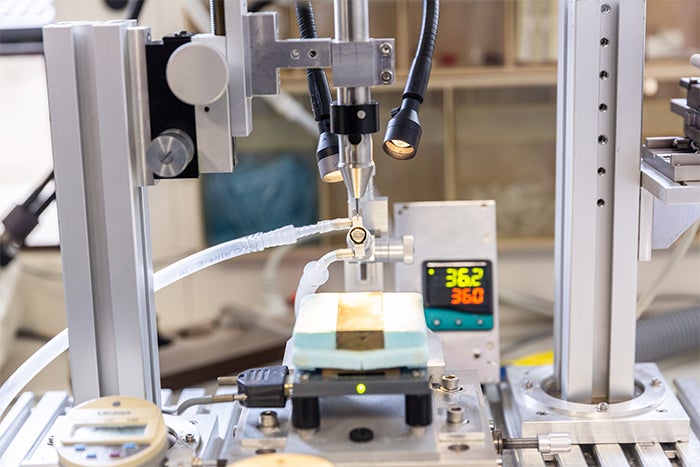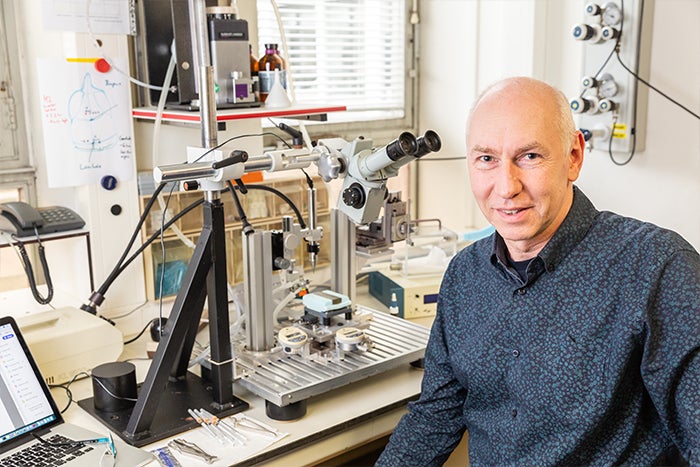Stereotaxic System STS100
Versatile stereotaxic system for surgeryThe highly advanced stereotaxic system STS100 has been developed in close collaboration of scientists and lab technicians of the Center for Neurogenomics and Cognitive Research (www.cncr.nl) with staff of the fine mechanics and electronics departments of Vrije Universiteit Amsterdam. The STS100 (Fig. 1) is adjustable for both right- and left-handed users. It has two arms with a drill and a pin/electrode holder that can be rotated and locked for stabile drilling and other surgical procedures
Features
STS100 includes the parts needed for all typical experiments
ULTIMATE STABILITY and ADJUSTABILITY
User friendliness for very FAST and ultimately PRECISE surgical procedures such as chronic cannula implantations (see References below)
ULTIMATE FLEXIBILITY for adjusting the system to different needs such as viral vector injections or in vivo electrophysiology. A variety of standard components can be added to the two arms on the same platform to meet all (advanced) experimental needs.
The STS100 includes a HEATING SYSTEM to maintain body temperature during the surgical procedure.
The STS100 includes a fixed DRILL and can be used for surgery instantly upon delivery - at least with injectable anesthesia if a gas anesthesia system is not available!
Standard system components
Stable aluminum base plate with four feet.
Two rotating arms:
Arm 1 with drill with fine and course manual Z-axis drive (dynamic range 7cm)
Arm 2 with cannula fixation pin or electrode holder
Animal platform with horizontal X- and Y-axis adjustment
X-Y indicators with 1 µm resolution that are resettable (e.g., after drill alignment to Bregma)
Heating block for body temperature control. Low noise temperature controller with an accuracy of +/- 0.2 0C, a resolution of 0.1°C and a maximum of 40°C. No rectal probe is required.
Nose adaptor for stabile head fixation for use with gas anesthesia or to inject anesthesia.
Electrode holder for glass micro-electrodes (range: 0.5-2 mm diameter)




Optional components for STS100
Optional add-on components (eg. ear bars, holder for stereo-microscope or cannula holder) can be manufactured on demand and in feedback with users.
Anesthesia gas evacuator (a box is provided as sink than can be connected to an air outlet to evacuate isoflurane leaking from the nose adapter).
Credentials
Read the credential of Oliver Stiedl, chairman of the Animal Welfare Body of VU & VUmc at VU University Amsterdam about the Stereotaxic system.
Publications
The STS100 was fundamental for experiments in mice described in these publications:
- Baarendse PJJ, van Grootheest G, Jansen RF, Pieneman AW, Ögren SO, Verhage M, Stiedl O (2008) Differential involvement of the dorsal hippocampus in passive avoidance in C57BL/6J and DBA/2J mice. Hippocampus 18, 11-19.
- Eriksson TM, Holst S, Stan TL, Hager T, Sjögren B, Ögren SO, Svenningsson P, Stiedl O (2012) 5-HT1A and 5-HT7 receptors crosstalk in the regulation of emotional learning: implications for the mechanisms of selective serotonin reuptake inhibitors. Neuropharmacology 63, 1150-1160.
- Misane I, Kruis A, Pieneman AW, Ögren SO, Stiedl O (2013) GABA. A receptor activation in the CA1 area of the dorsal hippocampus impairs conditioned contextual fear in C57BL/6J mice. Behavioural Brain Research 238, 160-169.
- Rao-Ruiz P, Rotaru DC, van der Loo R, Mansvelder H, Stiedl O, Smit AB, Spijker S (2011) Dorsohippocampal biphasic expression of GluA2-containing AMPARs is critical for reconsolidation-update of emotional memories. Nature Neuroscience 14, 1302-1308.
- Van den Oever MC, Rotaru DC, Heinsbroek JA, Yvonne Gouwenberg Y, Deisseroth K, Stuber GD, Mansvelder HD, Smit AB (2013) Ventromedial prefrontal cortex pyramidal cells have a temporal dynamic role in recall and extinction of cocaine-associated memory. Journal of Neuroscience 33, 18225-18233.
More information
Precision Mechanics and Engineering Group VU
Joost Rosier
T +31 20 59 87439
E j.c.rosier@vu.nl
In case of scientific and/or application questions please contact:
Oliver Stiedl
T +31 (0)20 5987100
E oliver.stiedl@cncr.vu.nl
